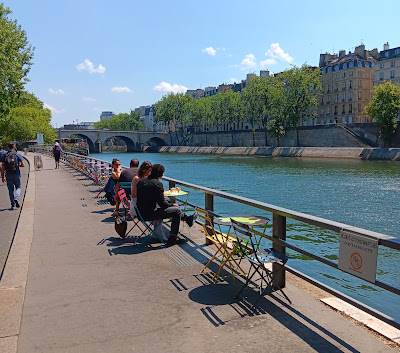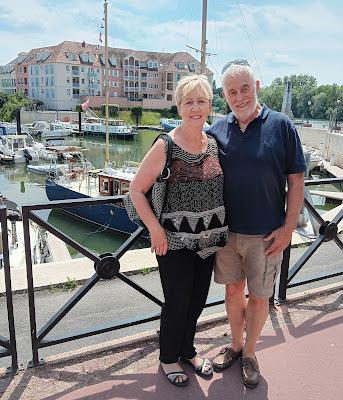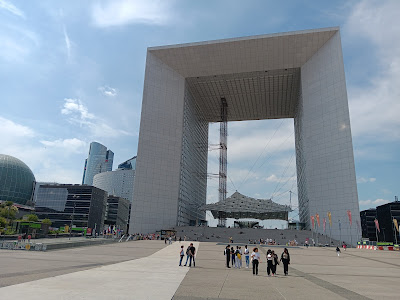Our last overnight stop on the Marne prior to reaching Paris was the town of Lagny-sur-Marne, a mere three-hour cruise from Meaux. We are happy to report that we had no Gilligan-style mishaps on the way.
 |
| We are definitely away from vineyards, but as close as we are to Paris, it still feels very rural. |
 |
| Lagny had a great halte nautique for our overnight stop. Any chance to plug into electricity is welcome. |
During the Middle Ages, Lagny was a popular place in Northern France for tournaments. It had a fortified castle . . . of which only remnants remain (and not in their original location). It had an old market hall . . . of which the arches remain. It had the Church of Saint-Fursy, sold during the Revolution . . . and of which only the western facade remains. It had an abbey and its church . . . of which the church still remains (although not all construction is still from the Middle Ages) and an abbey building from the 18th century (nowadays used as the Town Hall). Still, for all that was missing, the town had a very pleasant "feel" and we enjoyed the stop.
 |
| The western facade of Church of Saint-Fursy has been incorporated into a more modern building behind it. |
 |
| Lon passing under the arch of the former fortified entry leading to the old abbey courtyard area. |
Joan of Arc was in Lagny twice during her short life. During her visit in 1430, it is claimed that her prayers brought back to life an unbaptized, newborn infant who had been dead for three days. The child yawned three times, and started to regain color, but apparently lived only long enough to be baptized. For some reason, this was not one of the miracles listed in support of the process leading to the declaration of her sainthood in 1920.
 |
| A plaque in the church which contains an account of the miracle, as conveyed to the judges presiding over Joan's trial in Rouen after her arrest. |
We made the transition from suburban Lagny to urban Paris on Tuesday, June 6.
 |
| Starting to see more hints of the urban area to come. |
 |
| Our last tunnel. |
 |
| Sharing the last lock on the Marne with a commercial vessel. |
 |
| Making the Marne quays "beautiful"? |
 |
| A Chinese-themed hotel and restaurant marks the confluence of the Marne and the Seine. We were now about 4 kilometers upstream from our entrance into Port de Arsenal. |
 |
| First views of the Seine. This is not the side of Paris in which the Eiffel Tower is found. We will have to be satisfied with modern buildings and an industrial "vibe" for now. |
 |
| These may not have been the beautiful, historic buildings we love to see in central Paris, but they were interesting, nonetheless. |
Because we arrived in Paris a few days earlier than we had originally arranged with the Port de Arsenal, we had to take a temporary mooring for the first two days until our long-term slip was vacated. This temporary mooring had us rafted to another barge very close to the lock that separates the Seine from the Port. We used the two days to do tasks such as cleaning and grocery shopping, as well as simply to acclimate ourselves to a lifestyle where we weren't either cruising--or getting ready to cruise.
 |
| We had "entertainment" on Wednesday morning, when the local rescue service ran some practice drills in the port. |
 |
| A mid-week, mid-day stroll along the Seine is sedate and uncrowded. |
On Thursday, June 8, we were able to relocate to our "permanent" mooring. We are nearly all the way down the basin from the entry lock, essentially adjacent to the tunnel opening that leads to the Saint Martin Canal. All we have to do is pop up the stairs in front of the boat and we're in the Place de la Bastille.
Finally settled in one spot until June 27, on Friday we headed out to Port Cergy (where we had moored the boat last winter) to retrieve some official boat certification documents that had been mailed from the Netherlands. We always love the comparison between "boat time" and "land time." In this case, one hour via train and walking to get between Port Cergy and the Arsenal vs. five weeks by boat to travel by canal and river on the route we took. Of course, there were faster routes to cruise between the two locations, but we were really happy with the route we took and the experiences we had.
 |
| While in Cergy we had lunch with our Australian friends Rose and Steve, who are preparing for their own cruising season. |
On our return to the boat we stopped at the area of Paris known as La Defense. This is Europe's largest planned business district. It was named after a statue--La Defense de Paris--from 1883 that commemorated soldiers who had defended Paris in the Franco-Prussian War more than a decade earlier. Construction on the buildings started in the 1950's, and continued on-and-off into the 1990's. Being there was like stepping into a different world.
 |
| Inside the shopping mall are the balconies for the very modern Hilton Hotel. |
It was a bit of a relief to get back to historic Paris, where the scale of the buildings and the neighborhoods have a more "human" feel.
 |
| Our Friday night walk around the port. Parisiens love to picnic next to waterways in the evening, and the Arsenal became quite a hotspot of conviviality. Mostly, we just sat on our back deck and soaked in the atmosphere. |
We have lists of things we'd like to do while we're here, but we don't want to run ourselves ragged, so we'll see where things end up.







No comments:
Post a Comment